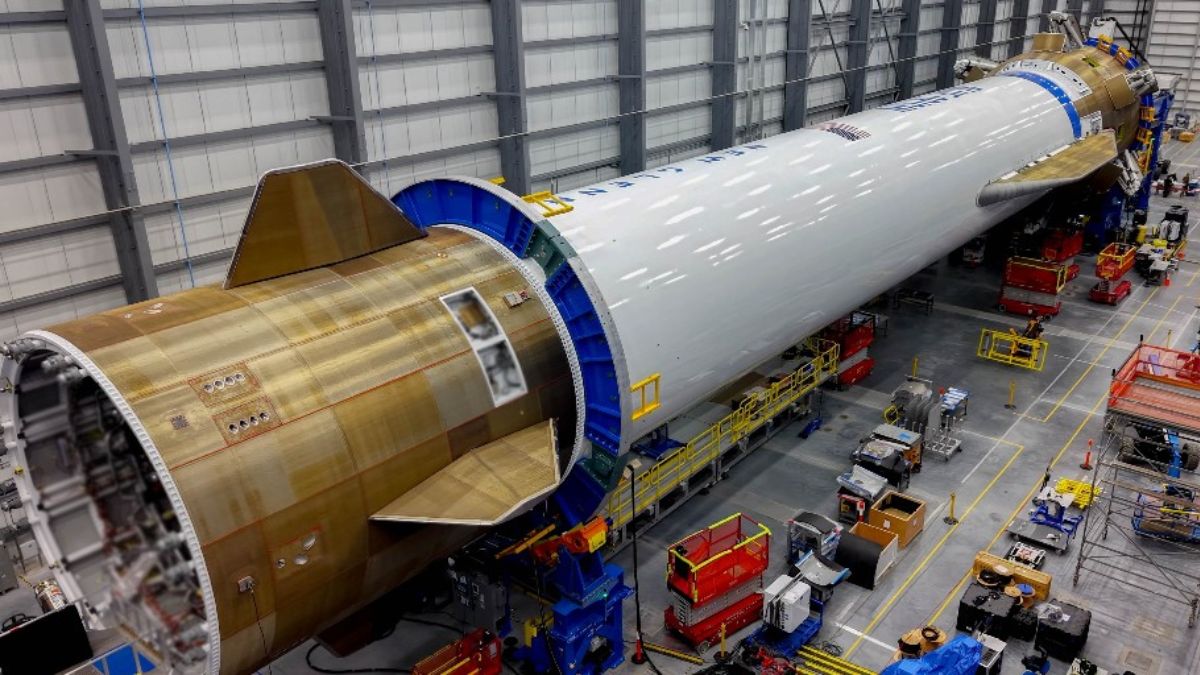Blue Origin-led NASA Mars mission to tackle the mysteries India once explored
 File photo of New Glenn rocket used in the mission | Blue Origin/X
File photo of New Glenn rocket used in the mission | Blue Origin/X
The ESCAPADE Mars mission that is being launched on behalf of NASA by Blue Origin, the private spaceflight firm headed by Jeff Bezos, is preparing to send two small spacecraft to Mars later this month or in November.
This mission will tackle the same big question that India's pioneering Mars mission explored: why is Mars losing its atmosphere? On October 8, 2025 (in the US), Blue Origin moved its massive New Glenn rocket to the launchpad in Florida.
The rocket will carry two NASA spacecraft called ESCAPADE probes, which stand for Escape and Plasma Acceleration and Dynamics Explorers. Their job is to study how Mars is slowly losing its atmosphere to space.
“Think of Mars as a balloon with a slow leak. Scientists want to know why and how fast the air is escaping. The two spacecraft, named Blue and Gold, will work together to measure how the solar wind, a constant stream of charged particles flowing from the Sun, strips away Mars's thin atmosphere bit by bit. This is where India's Mangalyaan mission becomes relevant. When ISRO sent the Mars Orbiter Mission to the Red Planet in 2013, it became the first Asian nation to reach Mars and the first country to succeed on its very first attempt. One of Mangalyaan's key objectives was also to study Mars' atmosphere and how it interacts with solar radiation. The mission operated for eight years before contact was lost in 2022, far exceeding its planned six to ten-month lifespan,” explained space analyst Girish Linganna.
Same question, new tech
The ESCAPADE mission will dive deeper into the same scientific question using more advanced technology. “While Mangalyaan studied Mars from a single orbit, these two American probes will provide measurements from two different locations at the same time. This dual-spacecraft approach will help scientists understand the real-time changes in Mars' atmosphere and magnetic field as the solar wind hits it,” added Linganna.
Experts point out that understanding how Mars lost its atmosphere is crucial because Mars was once warm and wet, possibly even capable of supporting life. If we can figure out what happened to its air and water, we can better understand whether other planets might be habitable and how Earth's own atmosphere might change over time.
For India, this mission is particularly relevant because ISRO is planning Mangalyaan-2, its next Mars mission. The mission received approval earlier this year and will be far more ambitious than the first, including not just an orbiter but also a rover, a helicopter similar to NASA's Ingenuity, and a sky crane landing system. As ISRO scientists design instruments for Mangalyaan-2, they will be watching closely to see what new techniques and discoveries ESCAPADE brings to Mars exploration.
India's success story
Mangalyaan's success story is worth remembering. India accomplished its first Mars mission on a shoestring budget of just Rs 450 crore, less than the cost of making a Hollywood space movie. The mission was so significant that the Reserve Bank of India (RBI) even featured an illustration of Mangalyaan on the country's 2,000 rupee currency note.
This upcoming launch also marks an important moment for Blue Origin. Unlike its first flight in January, which was mainly a test, this time the New Glenn rocket will carry a real scientific payload on an actual mission.
If successful, it shows that private American space companies can now handle deep-space exploration missions to other planets.
As private space companies like Blue Origin and SpaceX make rocket launches cheaper and more frequent, it opens doors for countries like India to book rides for their spacecraft at lower costs. ISRO has already partnered with international launch providers in the past, and missions like ESCAPADE show how reliable these commercial rockets are becoming for serious scientific work.
The two ESCAPADE probes were built by Rocket Lab in California and arrived in Florida in late September. They carry sophisticated instruments to measure magnetic fields, plasma, and particles around Mars. Working as a pair, they will help scientists understand how the Sun's activity affects Mars's atmosphere.
Mars today is cold and dry, and has an atmosphere so thin that water cannot exist as liquid on its surface. But billions of years ago, rivers flowed across its landscape and lakes filled its craters. The leading theory is that solar wind gradually stripped away the planet's protective atmosphere after Mars lost its magnetic field. ESCAPADE aims to catch this process in action and measure it precisely.
ESCAPADE will work alongside NASA's MAVEN spacecraft, which has been studying Mars's atmosphere since 2014. While MAVEN continues its observations, ESCAPADE's two spacecraft will provide simultaneous measurements from different locations, giving scientists a three-dimensional view of how the solar wind interacts with Mars.
For India, the relevance of this mission goes beyond just science. It shows how missions from different countries and organisations all contribute to answering big questions about the Red Planet. India was the first Asian nation to reach Mars, proving that space exploration is not just the domain of superpowers. As ISRO prepares Mangalyaan-2, every new Mars mission adds valuable knowledge that scientists worldwide, including those in India, can use to plan better experiments.
Sci/Tech